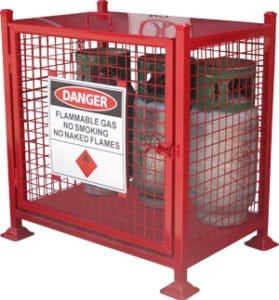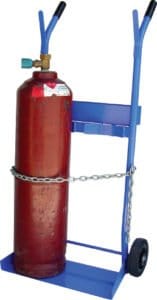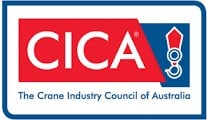Home / Blog / Health and Safety / Safe Storage of Gas Bottles
Safe Storage of Gas Bottles

First of all, LP gas is heavier than air and will accumulate in low areas and depressions, rather than dissipate. Thus, LP gas cylinders must be positioned so the pressure relief valve is in the vapour space of the cylinder. This means the cylinder must be stored in an upright position.
2. How to transport and move gas cylinders safely
The safe transportation and movement of gas cylinders is another issue to consider. Are you as safe as you could or should be? If you find your cylinders have been lying on their side, you should place the cylinder in the upright position and wait at least 30 minutes before using.
Australian Standards demonstrate, in AS1596 (The Storage and Handling of LP Gases published 2008), that LP gas cylinders must be handled carefully and not allowed to fall upon one another, or subjected to undue shock.

You can ensure that your gas cylinders are prevented from falling or being knocked over by securing them using a racking system or with a non abrasive, coated chain. It is very important that you guarantee this chain will not be abrasive to the cylinder markings and paint work.
4. Locate your gas cylinder storage outdoors
It is very important to always locate your gas stores outdoors. A secure gas bottle storage cage that is protected from sunlight is ideal. This is because gas cylinders need to be stored in well ventilated areas to prevent build up of escaped gases.
Unless you’re utilising a building that has been designed for gas storage, with appropriate fire rated walls and (usually mechanical) ventilation, you must not store gas cylinders (of any kind) indoors. Where gases are stored indoors, additional (and often costly) safety considerations and control measures need to be considered to ensure safe practice and non-liability.
5. Never store gas cylinders in areas or structures of combustible material
The Queensland Government advises that “gas stored indoors should be located on the ground floor away from other dangerous goods (e.g. Class 3, 4, 5, 6.1, 7, 8 or 9, etc) and combustible liquids (e.g. diesel fuel) stores by at least 5 m or more”.
6. Do not store cylinders below ground level
Meanwhile, storage below ground level should be avoided – especially if flammable, toxic or asphyxiated gases are present. Lifting and raising gas cylinders can be a safety logistical nightmare. Are you covered by the right solution?
Also, remember that as stated above, heavier than air gases need to be stored with caution to avoid storage where these gases can collect in low lying areas.
Finally, if you’re storing your gas cylinders indoors, avoid storing them in significant quantities near or inside protected places where members of the public may assemble. This could mean places of worship, theatres, aged care facilities, schools, hospitals, property boundaries and any other places where, in your judgement, members of the public may assemble.
7. Understand the Australian Safety Standard
Ultimately, storage of gas cylinders requires sound knowledge and understanding of – or consultation with someone experienced with – AS4332 (The Storage and Handling of Gases in Cylinders).
Copies of Australian Standards can be expensive, difficult to access and even more difficult to fully understand. Multiple Australian Standards can overlap, interweave and refer to one another. For these reasons, people often choose to consult with professionals and purchase the appropriate gas bottle storage.
If this means you, make sure your source of information is clear, experienced and has been proven to work in this industry for a long time.
Finally, anyone working with LPG, and any other workplaces where flammable gases are the dominant gas present, are urged to contact the Department of Mines and Energy for safe practice.
Sign up for our newsletter
Sign up for the Bremco newsletter and stay up to date on our latest projects, insights and industry news!




